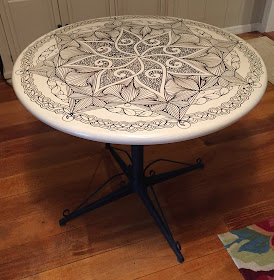Here are the details of the project, just in case a similar wish is on your "To Do" List...
Before I begin, I must say that the best part of this project was the fact that my friend Kathryn Crane-Thielen, CZT found, bought, sanded, painted, and sent the table along to me via our fellow CZT Carolyn Russell. Kathryn knew I was looking for a round table to tangle for the upcoming art show.
Kathryn is a very accomplished decorative painter, with an eye for furniture ripe for transformation and she certainly found it in this piece.
This is what the table looked like before Kathryn worked her magic -
The cast iron base has lovely scroll work and the top is a three foot circle of solid wood.
Once prepped, Kathryn sprayed a fresh coat of black to freshen up the base and applied a pure white latex (flat finish) to the top.
As for a design, I decided to recreate one of the pre-strung Zendalas included in the round tin kit from Zentangle®. (Click here to view) I find these templates wonderful for all types of projects.
I chose an even sectioned Zendala instead of an odd one. It proved to be much easier to divide the space into halves, fourths, eighths, etc.
Once I found the approximate center of the table, I marked the initial eight points by using a yard stick and lightly penciling first a cross, then an 'X' through the mid point. From there I drew the first petal from the midpoint to one of the outer points. In order to have the center sections uniform, using tracing paper and a pencil, I traced that petal and repeated it around the table seven more times ~
On a recommendation from Tracey Lyon, CZT, I decided to tangle the table with the new Sharpie Extreme markers. They come with a fade-resistant promise. (I'm holding them to it :)
I added aura and curls to transform the petals into Maria Thomas' Fengle pattern.
Next, I added Tipple to fill in the Fengle. I must admit that this was a tedious process. The 'zen' escaped me at times - mostly because I was anxious to move on to other tangles.
Once I finished half of the Tipple, I branched out into the next area, just to satisfy my curiosity ~
You may notice a few pens in the photographs. The felt nibs of the Sharpies wore away against the wood as I worked. Initially the tips made finer lines and then slowly became wider with use. This required adjustments with the pressure of my strokes - heavier with a fresh marker and lighter as I tangled on. When a marker line began to taper or skip, I opened a fresh one. By the time the table was complete, I used a total of 20 markers.
With the center completed, I outlined the next sections of the Zendala, divided them into smaller triangles, and added Rick Robert's Paradox.
A "creative opportunity" presented itself when I added Paradox to a section before I divided it into smaller triangles. The result was a much larger Paradox. Thankfully, working in even sections proved just the ticket. Moving forward, I alternated between two larger and two smaller sections around the Zendala.
The tips of the design were finished off with Lynn Mead's Fassett, with Fengle's Tipple in each middle triangle.
The two tangles blended beautifully together. Here is a close up ~
I repeated the Fengle curl at the tip of each of the eight outer points along with a bit of Tipple.
From there, I added a border of Zenith by Maria Thomas. I absolutely love how this tangle builds. Here is a close up of the first few steps
Once Zenith was complete, I took a longer than usual break from the project. I wasn't quite sure if it was finished or not - or how to finish it...
I decided to add CZT Amy Brody's Paisley Boa (much like Flux) and larger perfs to soften the sharp inner angels.
It was difficult to find a definitive answer from friends on what type of varnish to use on a Sharpie covered, painted surface. Everyone agreed that spray varnishes, if not used carefully, cause the marker to bleed. In an effort to cut down on that possibility, I set out to find a brush-on finish.
I painted and tangled a scrap piece of wood and tried numerous finishes. I was surprised and disappointed to find that a water based polyurethane caused the marker lines to blur.
Minwax Fast-Drying Polyurethane, Clear Semi-Gloss used carefully worked very well.
With a foam brush, I
*applied very thin coats
*wiped the brush with a paper towel after every three or four strokes to clean the bit of built up marker and to keep it from graying the white paint
*was always careful not to puddle the varnish or the marker lines would smear.
Each of the four varnished coats dried for eight to twelve hours. I then lightly sanded with a 220 grit paper, cleaned off the dust, and repeated the process.
Again, having Kathryn prep the table made a huge difference. From start to finish, working a few hours a day, it took me about a week to complete.
Once more...
The Before ...and After

ENJOY!


















































